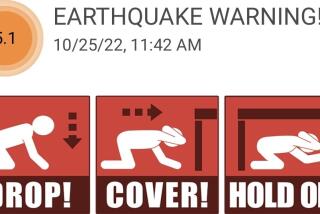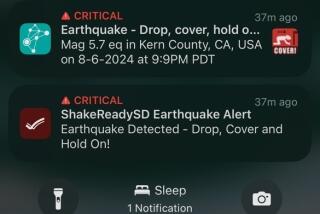Amber Alert Q&A: Why it happens, how to turn it off
The high-pitched Amber Alert that hit cellphones across Southern California overnight may have confounded and annoyed, but the text message also prompted a fresh round of questions.
Chief among them: Just what was that and how can I stop it from happening again?
What is it?
The Wireless Emergency Alert is a new program for cellphones that started Jan. 1, replacing the previous “opt-in” system.
Cellphone owners now receive messages automatically, based on their proximity to the emergency, not based on their phone number.
Can I opt out?
All newer models of cellphones come wired to automatically receive the alerts, which means it’s more of an opt-out system.
To opt-out of the emergency alerts, change your phone’s settings for emergency alerts.
How does it work?
An alert that looks like a standard text message reaches a user’s cellphone based on a number of criteria.
People who said they never got an alert, or received more than one, should keep in mind that the message is disseminated through cell towers, not phone numbers. And since cell towers are chosen on the basis of geographic proximity to the incident, it’s possible that moving between affected zones can factor into how many messages your phone recieves.
The signal is transmitted simultaneously to all mobile devices within the range of cell towers in the affected area. Authorities also broadcast the alerts multiple times to account for the movement of people in and out of these zones.
There are no texting charges, and the system does not track phones’ whereabouts.
According to the California Highway Patrol, “to attract attention, the messages are preceded and concluded with alert tones.”
Judging from public reaction Tuesday, mission accomplished.
When are they sent out?
For an Amber Alert to be issued in California, several criteria must be met.
Authorities must first confirm that an abduction has occurred and that it does not involve a runaway.
The victim(s) must be 17 or younger or have a proven mental or physical disability and be in “imminent danger of serious injury or death,” according to the CHP.
And, finally, there should be information available that, if provided to the public, could assist in the child’s safe recovery.
The system of checks has been successful in keeping the number of hoaxes relatively low. In 2012, there were 15 Amber Alert activations, with 19 victims recovered, the CHP reported. Just one incident was determined to be a hoax.
So I get an Amber Alert, what next?
Part of the confusion reported on social media Monday night and early Tuesday morning was tied to residents wondering what to do with the information.
A key part of the alert is information identifying the vehicle suspected of being involved in the abduction.
In the most recent case, authorities included the California license plate 6WCU986 for a blue Nissan four-door Versa.
Authorities believe James Lee DiMaggio is traveling in the car. He is suspected of killing Christina Anderson, 44, of Lakeside and kidnapping one or both of her children: Hannah Anderson, 16, and Ethan Anderson, 8.
Christina Anderson’s body was found Sunday night in the burning rubble of a house in the rural community of Boulevard in eastern San Diego County, authorities said. The two children were likely abducted about 5 p.m. on Saturday, authorities said.
Officials ask that drivers who spot vehicles listed in Amber Alerts call 911 to report the location.
ALSO:
Powerball jackpot soars to $425 million for Wednesday’s drawing
Nurse seeking to aid wounded Marine says Bob Filner harassed her
Opinion: Californians climb the learning curve for AMBER text alerts
jason.wells@latimes.com
More to Read
Sign up for Essential California
The most important California stories and recommendations in your inbox every morning.
You may occasionally receive promotional content from the Los Angeles Times.










